Unraveling the Intrinsic Mechanisms Controlling the Variations in Density, Sensitivity, and Thermal Decomposition of Typical Nitroguanidine Derivatives
Abstract
1. Introduction
2. Results and Discussion
2.1. Synthesis
2.2. Differences in Molecular and Crystal Structure
2.3. Differences in Thermal Decomposition Behavior
2.4. Differences in Physicochemical Properties
2.5. The Influence of the Introduced Group on Molecular Properties
2.6. The Influence of the Introduced Group on the Crystal Structure
3. Materials and Methods
3.1. Caution
3.2. General Procedures
3.3. Synthesis of Derivatives
3.3.1. 2-Nitroguanidine (NQ)
3.3.2. 1-Amino-2-nitroguanidine (ANQ)
3.3.3. 1-Amino-2-nitroguanidinium Nitrate (ANGN)
3.4. Calculation Details
4. Conclusions
- (1)
- The charged nature of ANGN enhances the hydrogen bonding network via stronger electrostatic and inductive interactions, leading to its higher density. In contrast, the lower maximum value of the positive electrostatic potential in ANQ weakens the hydrogen bonding network due to diminished electrostatic interactions, resulting in a lower density. These findings are consistent with the observed trend in crystal density: ANGN > NQ > ANQ.
- (2)
- The distribution of electrostatic potential of ANQ and ANGN becomes more inhomogeneous due to the introduction of -NH2 groups and NO3− anions, resulting in an increase in sensitivity. Furthermore, the frequency of O···O contacts and the strength of the hydrogen bonding network are also closely consistent with the experimental sensitivity order: ANGN ANQ NQ.
- (3)
- LOL- analysis reveals that the order of molecular conjugation strength is ANQ > NQ > ANGN due to the differences in the electronic effects of introduced groups, which aligns with the trend in N–NO2 bond dissociation energy and the corresponding yield of NO2 during decomposition. Furthermore, the trend in HOMO-LUMO gaps (NQ > ANQ > ANGN) successfully explains the thermal behavior: a larger gap can lead to a higher decomposition temperature.
Supplementary Materials
Author Contributions
Funding
Institutional Review Board Statement
Informed Consent Statement
Data Availability Statement
Conflicts of Interest
References
- Parakhin, V.V.; Smirnov, G.A. Research progress on design, synthesis and performance of energetic polynitro hexaazaisowurtzitane derivatives: Towards improved CL-20 analogues. FirePhysChem 2024, 4, 21–33. [Google Scholar] [CrossRef]
- Zhong, K.; Zhang, C. Review of the decomposition and energy release mechanisms of novel energetic materials. Chem. Eng. J. 2024, 483, 149202. [Google Scholar] [CrossRef]
- Qian, W.; Mardyukov, A.; Schreiner, P.R. Preparation of a neutral nitrogen allotrope hexanitrogen C2h-N6. Nature 2025, 642, 356–360. [Google Scholar] [CrossRef] [PubMed]
- Xu, Y.; Ding, L.; Yang, F.; Li, D.; Wang, P.; Lin, Q.; Lu, M. LiN5: A novel pentazolate salt with high nitrogen content. Chem. Eng. J. 2022, 429, 132399. [Google Scholar] [CrossRef]
- Kumar, P.; Mathpati, R.S.; Ghule, V.D.; Dharavath, S. Nitrogen-rich triazine, triazolo and tetrazolo-triazine-based energetic compounds: A new class of fluorinated organic explosives. Energetic Mater. Front. 2025, in publish. Available online: https://www.sciencedirect.com/science/article/pii/S266664722500051X?via%3Dihub (accessed on 20 August 2025).
- Saini, P.; Singh, J.; Staples, R.J.; Shreeve, J.N.M. Strategic integration of nitroimino and dinitromethyl explophores onto tetrazole: K2DNMNAT as a material with enhanced thermal stability and optimized oxygen balance. J. Mater. Chem. A 2025, 13, 17421. [Google Scholar] [CrossRef]
- Zhang, H.; Du, X.; Han, X.; Cheng, G.; Chen, W.; Xia, Y.; Lai, Q.; Yin, P.; Pang, S. Zero-oxygen balanced fused 1,2,3,4-tetrazine (TNF) as a high-performance energetic material. J. Mater. Chem. A 2024, 12, 32230–32238. [Google Scholar] [CrossRef]
- Meng, F.; Zhou, R.; Yuan, X.; Jiang, S.; Lu, M.; Xu, Y. Azide- and trinitromethyl-functionalized bitriazoles: Environmentally friendly high-nitrogen energetic materials with zero-oxygen balance. Org. Lett. 2025, 27, 10276–10280. [Google Scholar] [CrossRef]
- Koch, E.-C. Insensitive high explosives: IV. Nitroguanidine—Initiation & detonation. Defin. Technol. 2019, 15, 467–487. [Google Scholar]
- Bohn, M.A.; Heil, M.; Pontius, H.; Koch, E.C. Insensitive high explosives: VI. Experimental determination of the chemical compatibility of nitroguanidine with seven high explosives**. Propellants Explos. Pyrotech. 2024, 49, e202300055. [Google Scholar] [CrossRef]
- Klapötke, T.M.; Mieskes, F.; Stierstorfer, J.; Weyrauther, M. Studies on energetic salts based on (2,4,6-trinitrophenyl)guanidine. Propellants Explos. Pyrotech. 2016, 41, 217–222. [Google Scholar] [CrossRef]
- Wang, J.; Cai, M.; Zhao, F.; Xu, K. A review on the reactivity of 1-amino-2-nitroguanidine (ANQ). Molecules 2019, 24, 3616. [Google Scholar] [CrossRef]
- Wang, P.; Liu, B.; Ren, H.; Gao, C.; Du, Y.; Hu, B.; Sun, C. Exploring nonmetallic pentazolate salts with high density over 1.7 g·cm−3. Mater. Today Commun. 2025, 46, 112725. [Google Scholar] [CrossRef]
- Jin, X.; Hu, B.; Liu, Z.; Lv, C. Structure and properties of 1-amino-2-nitroguanidinium nitrate. RSC Adv. 2014, 4, 23898–23903. [Google Scholar] [CrossRef]
- Zhang, J.; Zhang, Q.; Vo, T.T.; Parrish, D.A.; Shreeve, J.N.M. Energetic salts with π-stacking and hydrogen-bonding interactions lead the way to future energetic materials. J. Am. Chem. Soc. 2015, 137, 1697–1704. [Google Scholar] [CrossRef]
- Zhang, J.; Dharavath, S.; Mitchell, L.A.; Parrish, D.A.; Shreeve, J.N.M. Energetic salts based on 3,5-bis(dinitromethyl)-1,2,4-triazole monoanion and dianion: Controllable preparation, characterization, and high performance. J. Am. Chem. Soc. 2016, 138, 7500–7503. [Google Scholar] [CrossRef]
- Bhatia, P.; Das, P.; Kumar, D. Engaging two anions with single cation in energetic salts: Approach for optimization of oxygen balance in energetic materials. ACS Appl. Mater. Interfaces 2024, 16, 64846–64857. [Google Scholar] [CrossRef]
- Fischer, N.; Klapötke, T.M.; Stierstorfer, J. 1-Amino-3-nitroguanidine (ANQ) in high-performance ionic energetic materials. Z. Naturforsch. B 2012, 67, 573–588. [Google Scholar] [CrossRef]
- Koch, E.C. Insensitive high explosives: III. Nitroguanidine—Synthesis—Structure—Spectroscopy—Sensitiveness. Propellants Explos. Pyrotech. 2019, 44, 267–292. [Google Scholar] [CrossRef]
- Tang, Y.; Zhang, J.; Mitchell, L.A.; Parrish, D.A.; Shreeve, J.N.M. Taming of 3,4-di(nitramino)furazan. J. Am. Chem. Soc. 2015, 137, 15984–15987. [Google Scholar] [CrossRef]
- Huynh, M.H.V.; Hiskey, M.A.; Hartline, E.L.; Montoya, D.P.; Gilardi, R. Polyazido high-nitrogen compounds: Hydrazo- and azo-1,3,5-triazine. Angew. Chem. Int. Ed. 2004, 43, 4924–4928. [Google Scholar] [CrossRef]
- Yu, Q.; Zheng, Z.; Yi, Z.; Yi, W.; Shreeve, J.N.M. Exploring the maximum potential of initiating ability in metal-free primary explosives. J. Am. Chem. Soc. 2025, 147, 5125–5131. [Google Scholar] [CrossRef]
- Reichel, M.; Dosch, D.; Klapötke, T.; Karaghiosoff, K. Correlation between structure and energetic properties of three nitroaromatic compounds: Bis(2,4-dinitrophenyl) ether, bis(2,4,6-trinitrophenyl) ether, and bis(2,4,6-trinitrophenyl) thioether. J. Am. Chem. Soc. 2019, 141, 19911–19916. [Google Scholar] [CrossRef] [PubMed]
- Bao, G.; Abe, R.Y.; Akutsu, Y. Bond dissociation energy and thermal stability of energetic materials. J. Therm. Anal. Calorim. 2021, 143, 3439–3445. [Google Scholar] [CrossRef]
- Lu, T.; Chen, Q. Simple, efficient, and universal energy decomposition analysis method based on dispersion-corrected density functional theory. J. Phys. Chem. A 2023, 127, 7023–7035. [Google Scholar] [CrossRef] [PubMed]
- Kretić, D.S.; Radovanović, J.I.; Veljković, D.Ž. Can the sensitivity of energetic materials be tuned by using hydrogen bonds? Another look at the role of hydrogen bonding in the design of high energetic compounds. Phys. Chem. Chem. Phys. 2021, 23, 7472–7479. [Google Scholar] [CrossRef]
- Frisch, M.J.; Trucks, G.W.; Schlegel, H.B.; Scuseria, G.E.; Robb, M.A.; Cheeseman, J.R.; Scalmani, G.; Barone, V.; Petersson, G.A.; Nakatsuji, H.; et al. Gaussian 16 Rev. A.03; Gaussian: Wallingford, CT, USA, 2016. [Google Scholar]
- Zhang, J.; Lu, T. Efficient evaluation of electrostatic potential with computerized optimized code. Phys. Chem. Chem. Phys. 2021, 23, 20323–20328. [Google Scholar] [CrossRef] [PubMed]
- Lu, T.; Chen, F. Quantitative analysis of molecular surface based on improved marching tetrahedra algorithm. J. Mol. Graph. Modell. 2012, 38, 314–323. [Google Scholar] [CrossRef]
- Lu, T.; Chen, Q. Independent gradient model based on Hirshfeld partition: A new method for visual study of interactions in chemical systems. J. Comput. Chem. 2022, 43, 539–555. [Google Scholar] [CrossRef]
- Lu, T.; Chen, F. Multiwfn: A multifunctional wavefunction analyzer. J. Comput. Chem. 2012, 33, 580–592. [Google Scholar] [CrossRef]
- Lu, T. A comprehensive electron wavefunction analysis toolbox for chemists, Multiwfn. J. Chem. Phys. 2024, 161, 082503. [Google Scholar] [CrossRef]
- Humphrey, W.; Dalke, A.; Schulten, K. VMD: Visual molecular dynamics. J. Mol. Graph. 1996, 14, 33–38. [Google Scholar] [CrossRef] [PubMed]
- Grimme, S.; Antony, J.; Ehrlich, S.; Krieg, H. A consistent and accurate ab initio parametrization of density functional dispersion correction (DFT-D) for the 94 elements H-Pu. J. Chem. Phys. 2010, 132, 154104. [Google Scholar] [CrossRef] [PubMed]
- Krishnan, R.; Binkley, J.S.; Seeger, R.; Pople, J.A. Self-consistent molecular orbital methods. XX. A basis set for correlated wave functions. J. Chem. Phys. 1980, 72, 650–654. [Google Scholar] [CrossRef]
- Feller, D. The role of databases in support of computational chemistry calculations. J. Comput. Chem. 1996, 17, 1571–1586. [Google Scholar] [CrossRef]
- Schuchardt, K.L.; Didier, B.T.; Elsethagen, T.; Sun, L.; Gurumoorthi, V.; Chase, J.; Li, J.; Windus, T.L. Basis set exchange: A community database for computational sciences. J. Chem. Inf. Model. 2007, 47, 1045–1052. [Google Scholar] [CrossRef]
- Pritchard, B.P.; Altarawy, D.; Didier, B.; Gibsom, T.D.; Windus, T.L. A new basis set exchange: An open, up-to-date resource for the molecular sciences community. J. Chem. Inf. Model. 2019, 59, 4814–4820. [Google Scholar] [CrossRef]
- Clark, T.; Chandrasekhar, J.; Spitznagel, G.W.; Schleyer, P.V.R. Efficient diffuse function-augmented basis sets for anion calculations. III. The 3-21+G basis set for first-row elements, Li-F. J. Comput. Chem. 1983, 4, 294–301. [Google Scholar] [CrossRef]
- Stephens, P.J.; Devlin, F.J.; Chabalowski, C.F.; Frisch, M.J. Ab initio calculation of vibrational absorption and circular dichroism spectra using density functional force fields. J. Phys. Chem. 1994, 98, 11623–11627. [Google Scholar] [CrossRef]
- Zhao, Y.; Truhlar, D.G. The M06 suite of density functionals for main group thermochemistry, thermochemical kinetics, noncovalent interactions, excited states, and transition elements: Two new functionals and systematic testing of four M06-class functionals and 12 other function. Theor. Chem. Acc. 2008, 120, 215–241. [Google Scholar] [CrossRef]
- Weigend, F.; Furche, F.; Ahlrichs, R. Gaussian basis sets of quadruple zeta valence quality for atoms H-Kr. J. Chem. Phys. 2003, 119, 12753–12762. [Google Scholar] [CrossRef]
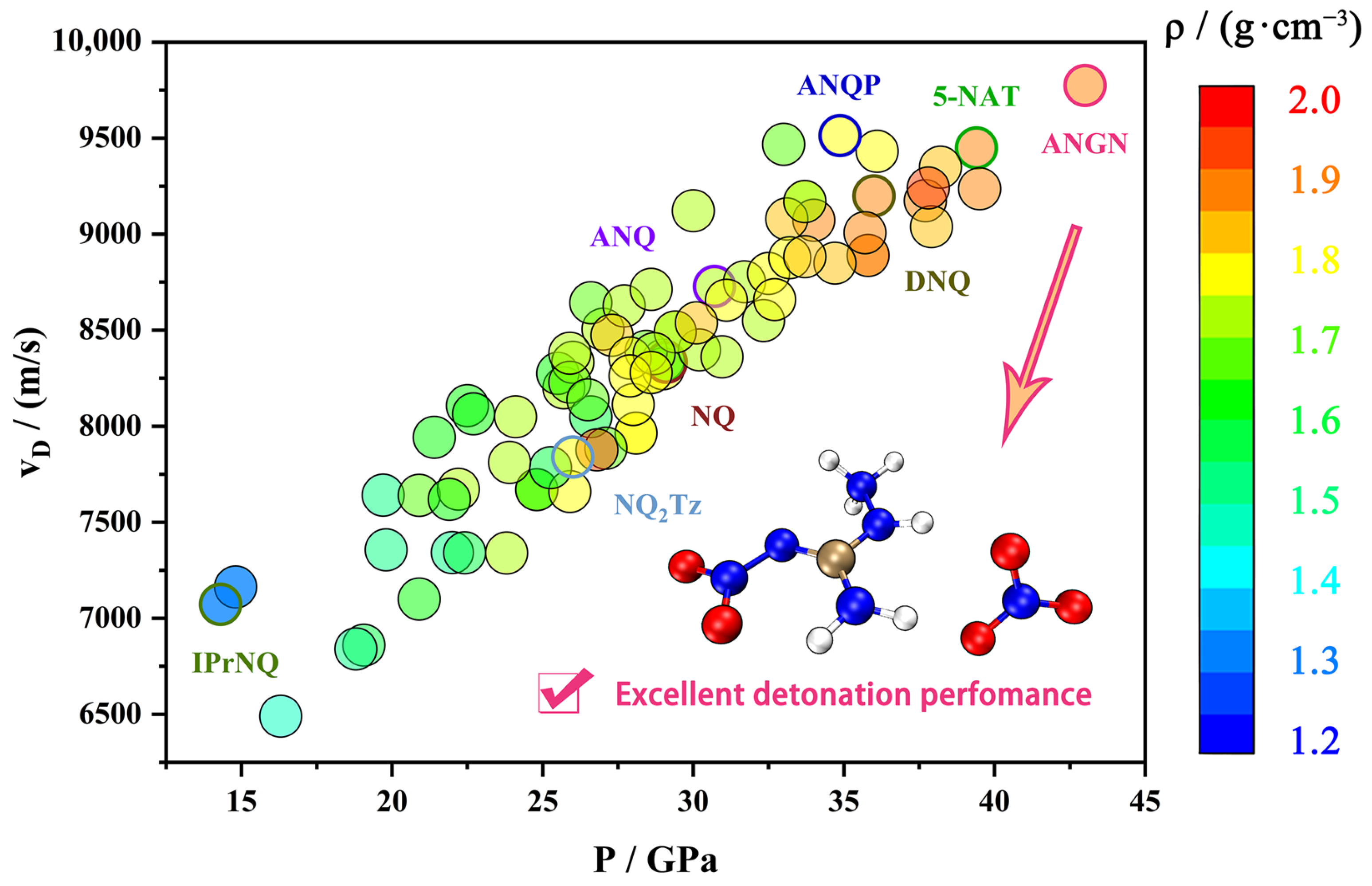


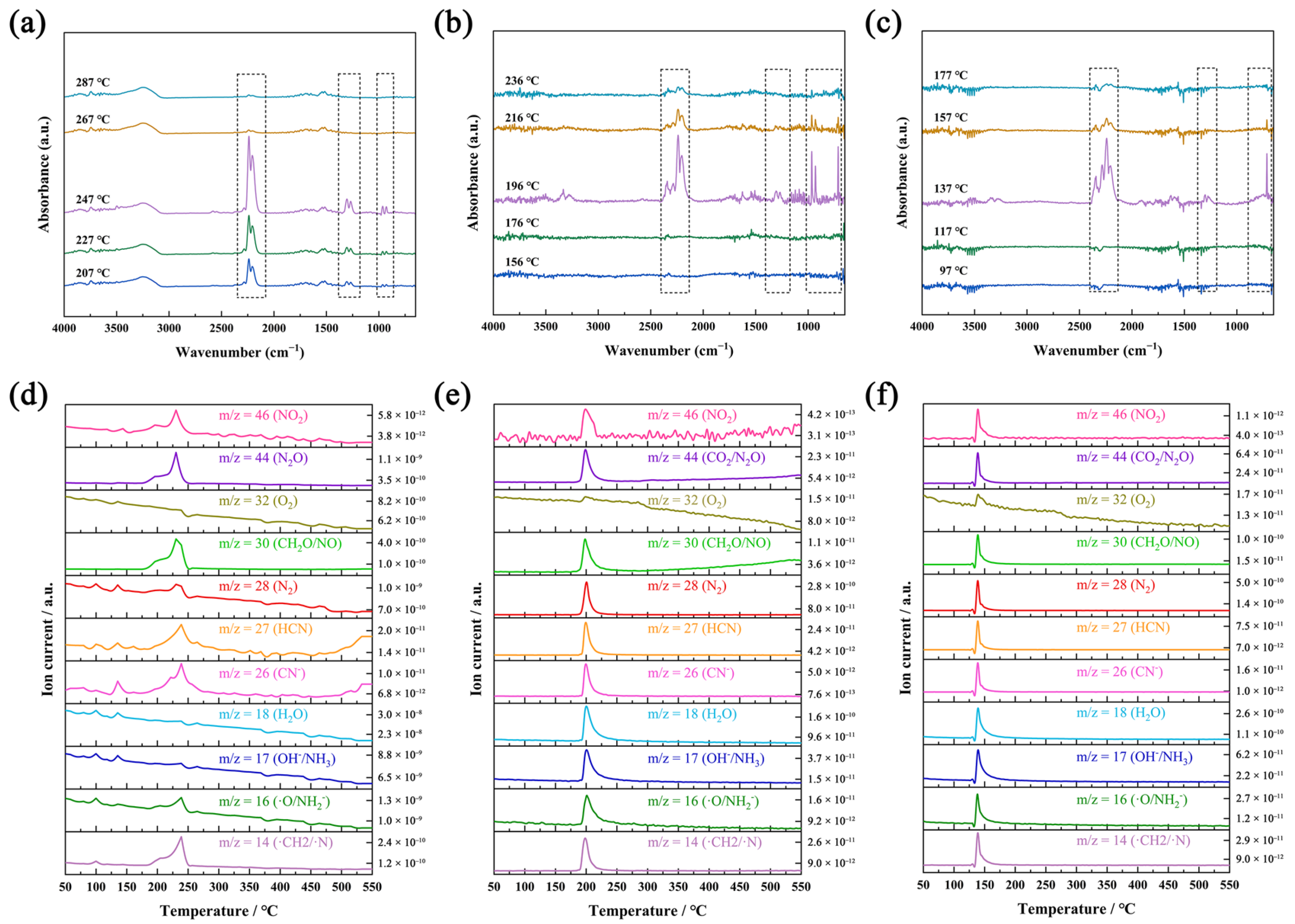
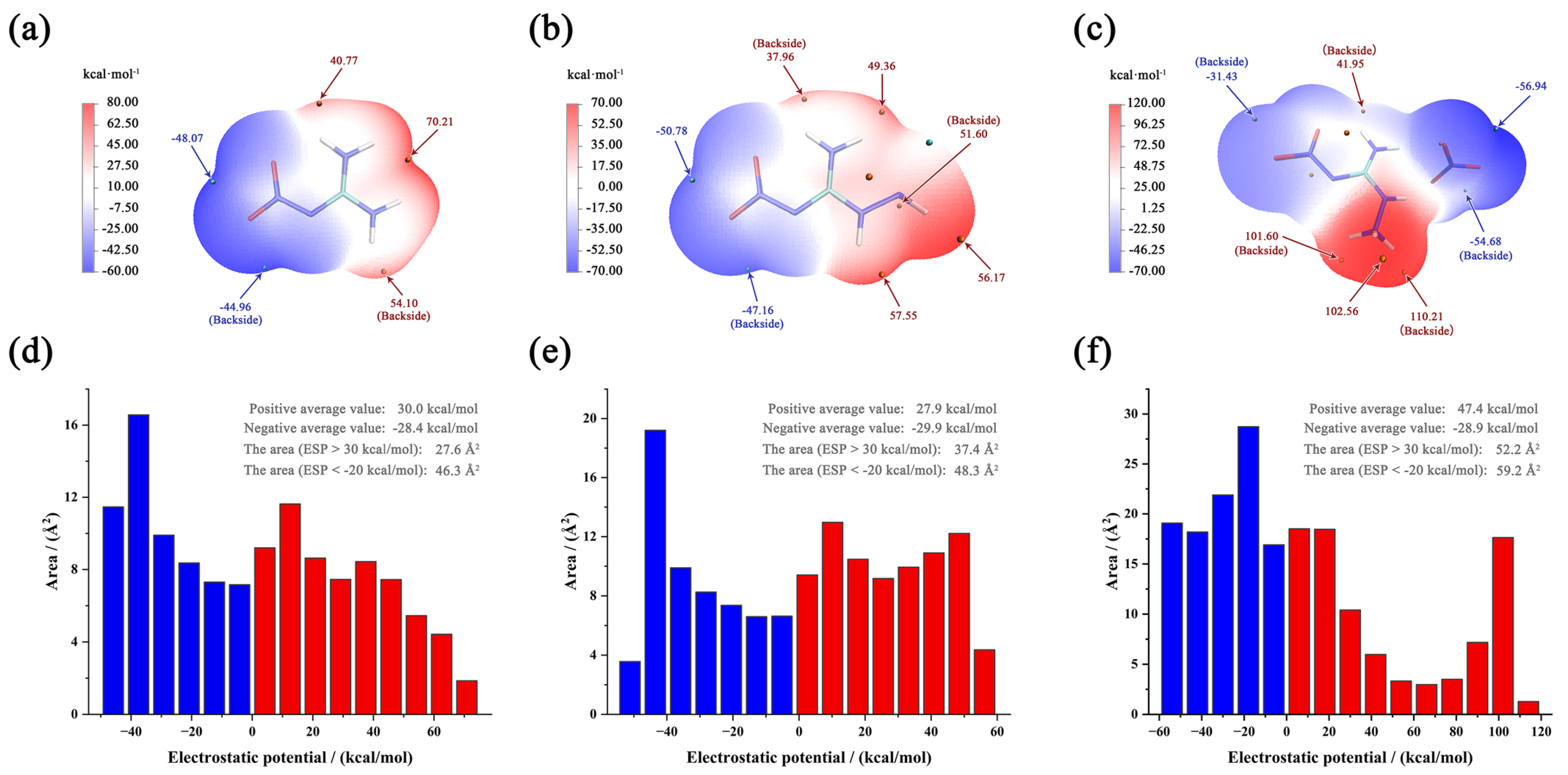
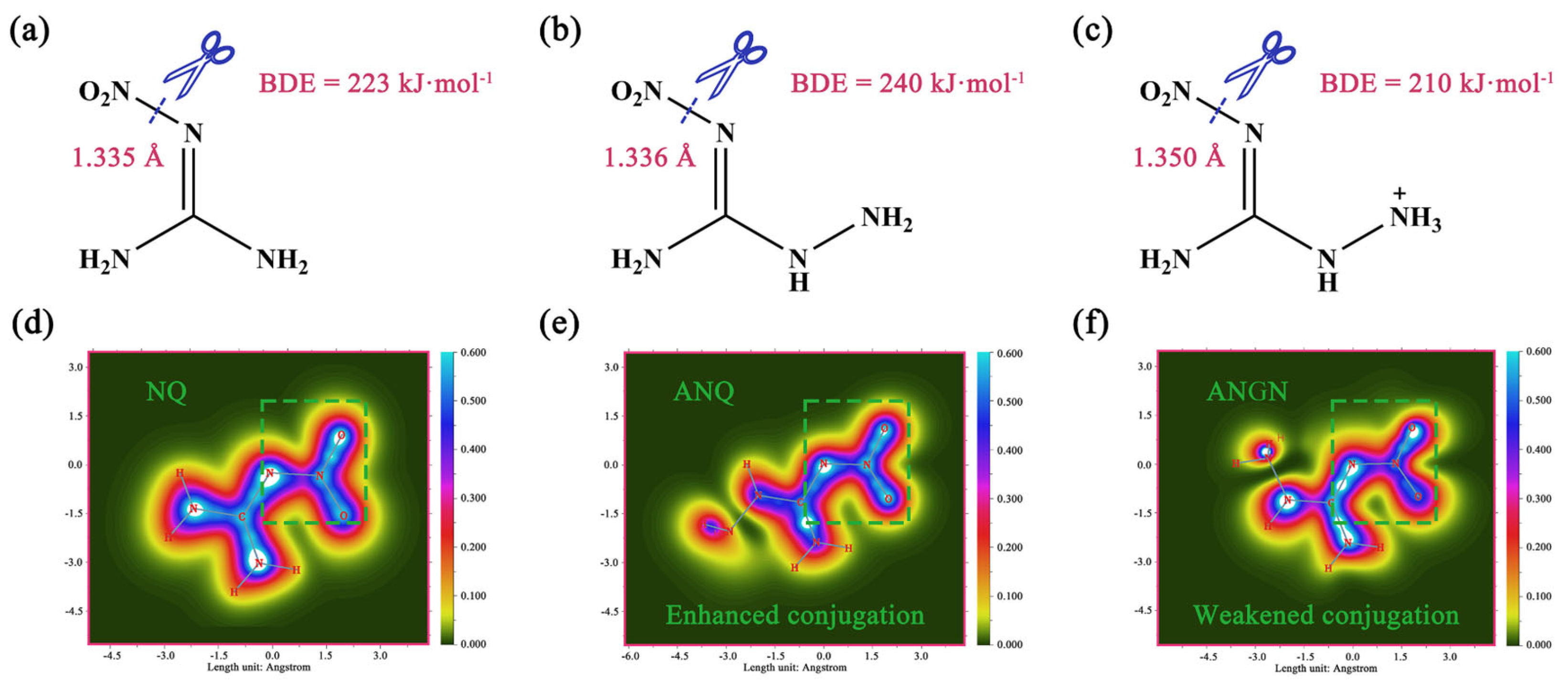
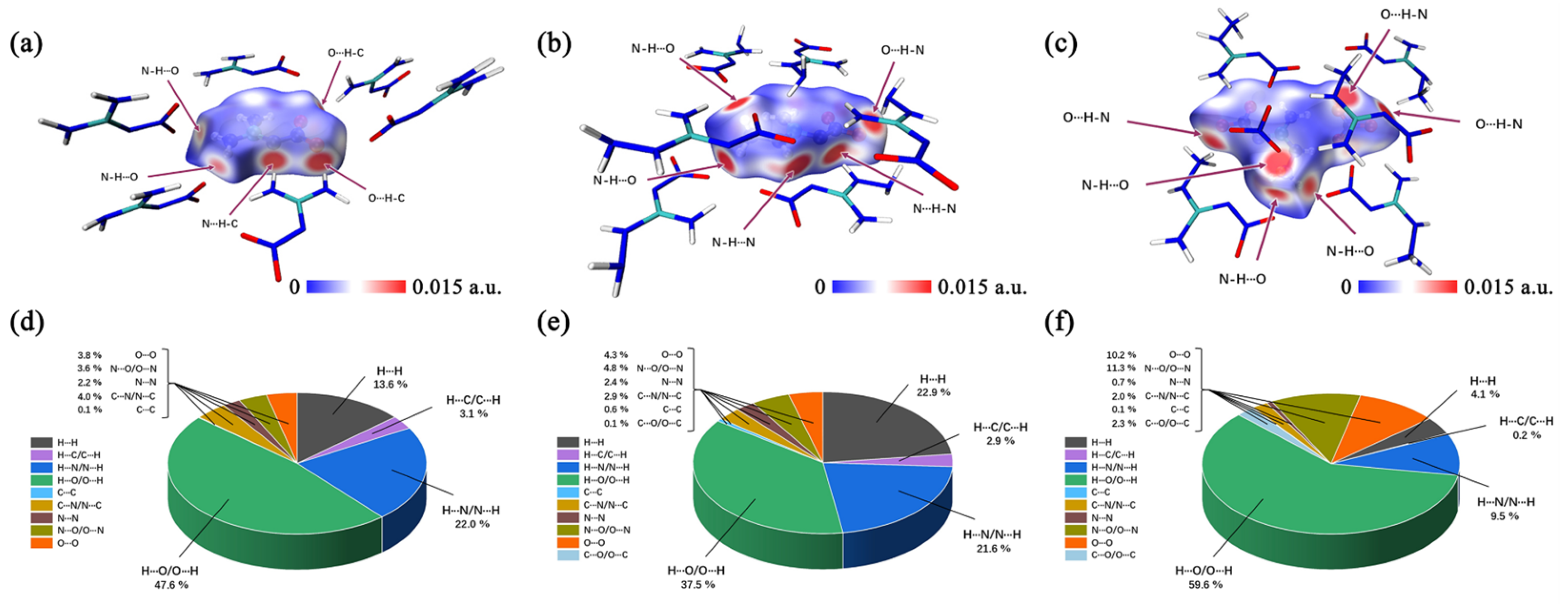
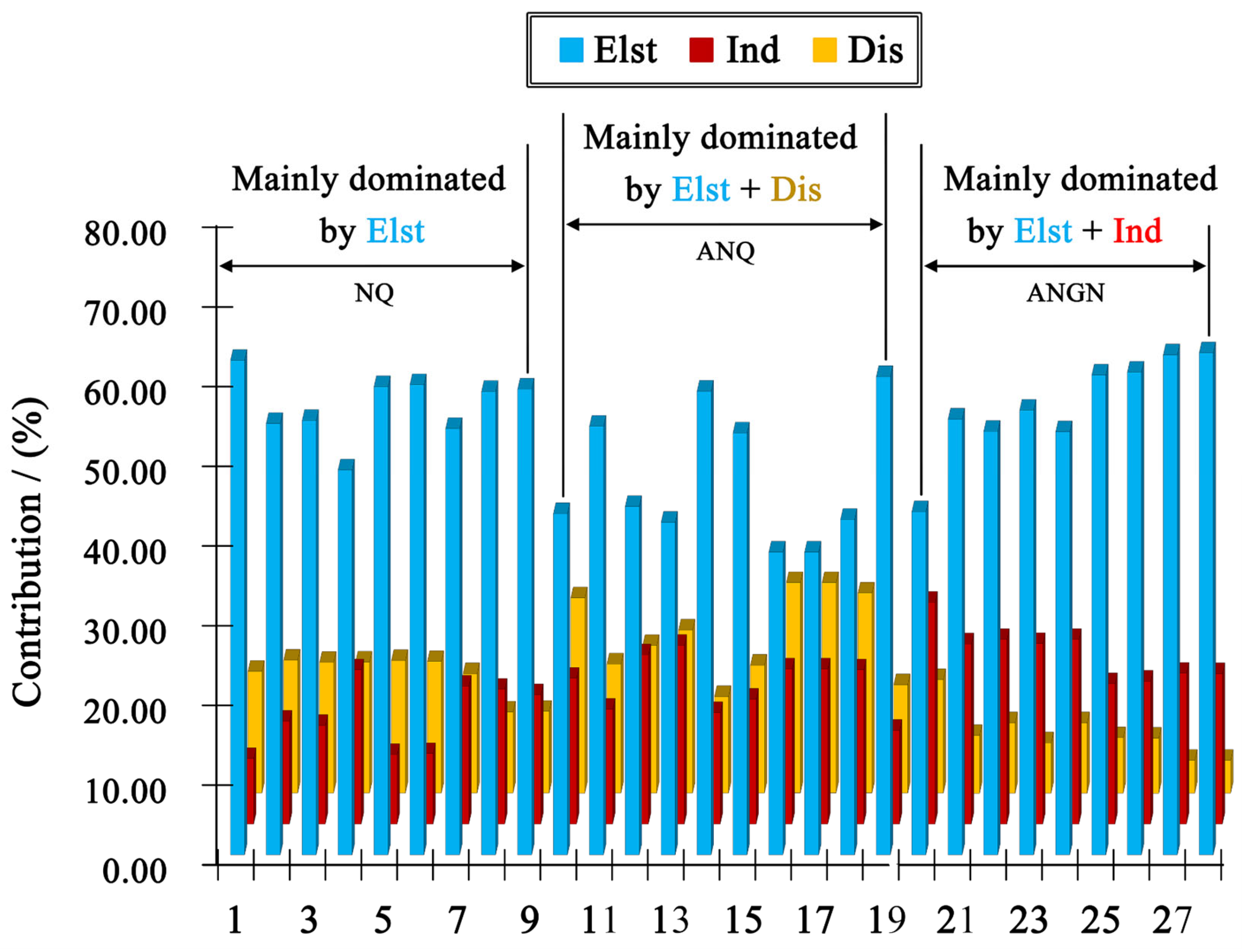
| NQ | ANQ | ANGN | RDX | HMX | CL-20 | |
|---|---|---|---|---|---|---|
| OB a/[%] | −30.8 | −33.6 | 0.0 | −21.6 | −21.6 | 11.0 |
| b/[gcm−3] | 1.76 | 1.72 | 1.85 | 1.80 | 1.91 | 2.04 |
| fH c/[kJmol−1] | −86.0 | 76.9 | 15.5 | 71.1 | 74.0 | 377 |
| VD d/[ms−1] | 8629 | 9096 | 9438 | 8794 | 9198 | 9754 |
| P e/[GPa] | 27.7 | 31.1 | 40.2 | 33.7 | 38.2 | 44.9 |
| Q f/[kJkg−1] | 3563 | 4631 | 6230 | 5715 | 5671 | 6172 |
| Isp g/[s−1] | 209.2 | 238.2 | 274.4 | 266.5 | 265.1 | 270.8 |
| h/[kJkg−1] | 980.7 | 1243 | 1361 | 1385 | 1365 | 1313 |
| Td i/[°C] | 254 | 184 | 148 | 204 | 275 | 215 |
| IS j/[J] | 50 | 20 | 10 | 7.4 | 7.4 | 4 |
| FS k/[N] | 355 | 144 | 120 | 120 | 120 | 48 |
| Ref l | [19] | [18] | [14] | [20] | [20] | [21] |
Disclaimer/Publisher’s Note: The statements, opinions and data contained in all publications are solely those of the individual author(s) and contributor(s) and not of MDPI and/or the editor(s). MDPI and/or the editor(s) disclaim responsibility for any injury to people or property resulting from any ideas, methods, instructions or products referred to in the content. |
© 2025 by the authors. Licensee MDPI, Basel, Switzerland. This article is an open access article distributed under the terms and conditions of the Creative Commons Attribution (CC BY) license (https://creativecommons.org/licenses/by/4.0/).
Share and Cite
Geng, P.; Guo, S.; Wang, X.; Xing, C.; Qu, C.; Luan, J.; Ding, K. Unraveling the Intrinsic Mechanisms Controlling the Variations in Density, Sensitivity, and Thermal Decomposition of Typical Nitroguanidine Derivatives. Molecules 2025, 30, 4204. https://doi.org/10.3390/molecules30214204
Geng P, Guo S, Wang X, Xing C, Qu C, Luan J, Ding K. Unraveling the Intrinsic Mechanisms Controlling the Variations in Density, Sensitivity, and Thermal Decomposition of Typical Nitroguanidine Derivatives. Molecules. 2025; 30(21):4204. https://doi.org/10.3390/molecules30214204
Chicago/Turabian StyleGeng, Pengshan, Songsong Guo, Xiaohong Wang, Chao Xing, Chenxi Qu, Jieyu Luan, and Kewei Ding. 2025. "Unraveling the Intrinsic Mechanisms Controlling the Variations in Density, Sensitivity, and Thermal Decomposition of Typical Nitroguanidine Derivatives" Molecules 30, no. 21: 4204. https://doi.org/10.3390/molecules30214204
APA StyleGeng, P., Guo, S., Wang, X., Xing, C., Qu, C., Luan, J., & Ding, K. (2025). Unraveling the Intrinsic Mechanisms Controlling the Variations in Density, Sensitivity, and Thermal Decomposition of Typical Nitroguanidine Derivatives. Molecules, 30(21), 4204. https://doi.org/10.3390/molecules30214204






